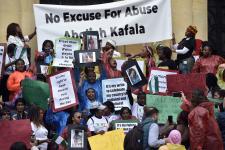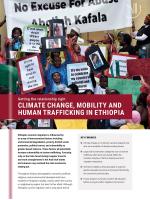Climate change, mobility and human trafficking in Ethiopia

- Climate change is not directly causing migration but acts as an amplifier of already existing drivers.
- Legal and humanitarian categories such as human trafficking often fail to accurately reflect the complex interplay of factors shaping women’s migration trajectories.
- Women’s mobility is often grounded in systemic gender inequality occurring at the level of the family, the community and the state.
- Future analysis must take women’s life situation before, during and after migration into account.
Throughout history, demographic, economic, political, religious, and environmental developments have resulted in Ethiopian mobility, mainly within the country or neighbouring region, but also further afield. Although Ethiopia’s current migration rate is only about half of the sub-Saharan average of 2%, the combined effects of poverty, population growth, conflict, and climate change have led to a recent growth in international migration. Women make up half of these flows.
Proximity to the Middle East has facilitated women’s migration for domestic work while simultaneously raised concern over human trafficking violations. International Human Rights and anti-trafficking organisations predict that the negative effects of climate change will increase the vulnerability to trafficking in persons, forced labour, sexual exploitation, and debt bondage.
This policy brief draws on research carried out under the auspices of the collaborative ‘Governing Climate Migration’ (GCM) research programme to further explore how climate change, migration and human trafficking may interlink. It questions routine applications of the human trafficking label to irregular Ethiopian migrant domestic workers and suggests replacing it with a migration-trafficking continuum approach that takes life before, during and after migration into account.
Climate change and migration
While no conclusive evidence regarding the influence of climate change on the magnitude, direction and gender composition of Ethiopian migration can be found, findings indicate that local employment opportunities primarily facilitate men’s seasonal and/or temporary internal migration in response to climate change impacts. A critical lack of local pathways for women makes migration to the Middle East a reasonable adaptive and capability-enhancing strategy. The newly established industrial parks seem to have little effect on halting migration, primarily due to low wages.
Numbers and ways of travel
Ethiopia is one of the main suppliers of domestic workers to the Gulf and Middle East. Throughout the 1980s and early 1990s, some 30,000 women left Ethiopia for the Middle East every year. This number has risen steadily over the years, not least through bilateral agreements made between the Ethiopian government and individual states. Recent estimates vary. Around 750,000 Ethiopian workers were believed to reside in Saudi Arabia in 2022, and another 200,000 in Lebanon. Other countries in the region have also attracted Ethiopian domestic workers.
In response to domestic pressure to protect migrant workers and international pressure to halt irregular migration, the Ethiopian government imposed a ban on domestic workers moving overseas in 2013, which it subsequently revoked and replaced with the Overseas Employment Proclamations amid attempts to regulate recruitment and employment agencies in 2018. An unintended consequence of the ban was a rise in irregular travel arrangements, both during and after the implementation of the ban. At present, more than half of Ethiopian domestic workers abroad have irregular status.
Travels organized by recruitment and employment agencies tend to be by air and are therefore considered less risky than over land and sea. When regulated by bilateral agreements, they supposedly include legal protections. When traveling over land, human smugglers may be involved, but migrant women tend to rely on family networks and trusted community brokers. Findings indicate a wide range in travel assistance arrangements and costs, the latter ranging from 10,000 ETB (approximately 185 USD) in Amhara regional state to 60-70,000 ETB in Oromia regional state. Respondents evoked cases of deceit, confinement and extra pay along the route. Many nevertheless referred to the assistance obtained as a necessary protective measure when traveling irregularly.
Working conditions abroad
Jordan, Lebanon, and all Arab Gulf States (except Iraq and since 2018 Qatar) regulate migrant residency and employment through a sponsorship system known as kafala. The system connects foreign workers with specific employers and outlines their relationship. A local citizen must sponsor any foreign worker for their residency and work visa to be valid. Sponsors are supposed to cover the travel and living expenses of their workers, as well as health insurance. A lack of regulation and protection of migrant workers’ rights, as well as restrictions on changing employers, have historically made domestic workers vulnerable to exploitation. The system is currently under revision in several states.
Gruelling working conditions and incidents of abuse abound. Hardship is more pronounced among recent arrivers due to language difficulties and limited knowledge of the content of the work and ways of carrying it out. But women also find ways of altering their working conditions, either by changing employers or by moving from employment as live-in domestic workers to working by the hour, the latter arrangement involving a considerable rise in earnings.
Human trafficking
Human trafficking refers to the recruitment,
transportation, transfer, harbouring or receipt
of persons, by use of threat, force or other forms of coercion. To qualify as human trafficking,
three elements must be present:
- The act of transferring, transporting, or recruiting a person, by
- Using the means of threat, coercion, force, deception or abduction to control the person,
- With the purpose of forced labour, sexual exploitation and slavery.
Ethiopia has for years been identified as a country with a burgeoning human trafficking problem in the form of forced adult and child labour and sex, organ harvesting, and domestic servitude. Multiple layers of structural disadvantages rooted in gender inequalities in the family and society are making women and girls more vulnerable to human trafficking.
The US Government office to Monitor and Combat Trafficking in Persons has placed Ethiopia on the Tier Two Watch List continuously over the past 20 years, indicating that the Government of Ethiopia – despite progress - does not fully meet the minimum standards for eliminating human trafficking within and from the country. The 2022 report criticizes Ethiopian government officials for continuing to conflate human trafficking and migrant smuggling, for insufficient efforts directed at protecting migrant workers abroad, and for inadequate protection services for potential victims of trafficking being returned.
GCM findings confirm a widespread conflation of irregular migration with human smuggling and trafficking among public authorities. The politization of the human trafficking label has led national authorities to adopt anti-trafficking legislation without necessarily providing state resources for its implementation. Local job creation and vocational training offices, as well as offices dedicated to promoting the welfare of women, children and youth, often rely on NGO funding for rehabilitation of returned/deported migrants. Donor interests in combating human smuggling and trafficking – rather than local migration-related
needs – often determine the funds available.
A note of caution
Knowledge of human trafficking tends to be based on victim accounts gathered by NGOs and international
In 2022, an Ethiopian woman was the first domestic worker in Lebanon to file a criminal complaint against her employer for illegal confinement, torture, verbal and physical abuse and intimidation over a period of eight years.
organisations. The accounts have shown that human trafficking is indeed a serious problem that must
be ended. However, empirical studies based on victim accounts, or scoping studies identifying risk factors potentially leading to human trafficking, risk generalizing the idea that all women who travel irregularly fall prey to human traffickers and experience abuse. They also risk turning attention away from national socio-cultural, political and structural factors constituting important risks in women’s lives.
Beyond economic drivers
Ethiopia is home to 15 million child brides, 6 million of whom are below the age of 15. 40% of young women are married before their 18th birthday.
The structural forces underlying Ethiopian women’s irregular mobility may be better understood as embedded in broader demographic, political and economic transitions occurring across the country.
Migration often occurs at a particular moment in a woman’s life course, for instance when transitioning from adolescence into adulthood. Young girls may be ‘sent off’ by their parents with the aim of supporting those who stay behind; but migration may also be a means to escape an early forced marriage.
Thus, women’s mobility can be part of a household strategy or be influenced by a wish to escape parental or societal control.
Ethiopian women face disproportionate levels of violence when navigating multiple concurrent transition processes. In some rural areas violence against women and children is prevalent. Up to a third of Ethiopian women are reportedly subjected to intimate partner violence. Living in rural areas, being divorced and being poor are among the main predicters. Consequently, women’s migration can be a way to escape gender-based and intimate partner violence, or a way for poor and/or single mothers to support their children.
Conclusion
Ethiopian women’s migration is conditioned by a range of interlinked factors, including environmental degradation, poverty, recurrent famine, poor governance, limited social protection provision, political unrest, and vulnerability to domestic violence. Rather than predetermining their mobility as human trafficking, a continuum understanding based on the idea that the point at which tolerable conditions end and human trafficking begins is set where threat, force and coercion are present in recruitment, transfer and labour conditions.
At one end of the continuum are women who have been thoroughly deceived about travel and working conditions, are confined to the domestic workplace by the kafala system, fall into debt bondage, and are physically or sexually abused. At the other end are women who operate with some knowledge and agency, and who are not necessarily deceived or mistreated by brokers and employers. Irregular Ethiopian women migrants often move back and forth along the continuum during their migration trajectory. To put their vulnerability into perspective, we need to take their lives before, during and after migration into consideration.
This policy brief draws on findings from the ‘Governing Climate Mobility’ (GCM) research program, which explores the relations between climate change, migration and governance. GCM is a collaborative research program with partners in Ghana (Centre for Migration Studies, University of Ghana), Ethiopia (Forum for Social Studies) and Denmark (Danish Institute for International Studies). It is an independent research program funded by the Ministry of Foreign Affairs of Denmark.
DIIS Experts


